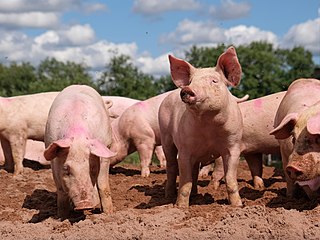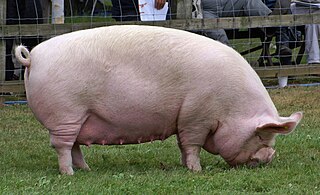Related Research Articles

Sus is the genus of wild and domestic pigs, within the even-toed ungulate family Suidae. Sus include domestic pigs and their ancestor, the common Eurasian wild boar, along with other species. Sus species, like all suids, are native to the Eurasian and African continents, ranging from Europe to the Pacific islands. Suids other than the pig are the babirusa of Indonesia, the pygmy hog of South Asia, the warthogs of Africa, and other pig genera from Africa. The suids are a sister clade to peccaries.

The Hereford is a British breed of beef cattle originally from Herefordshire in the West Midlands of England. It has spread to many countries – there are more than five million purebred Hereford cattle in over fifty nations worldwide. The breed was first exported from Britain in 1817, initially to Kentucky. It spread across the United States and Canada, through Mexico, to the great beef-raising countries of South America. Today Herefords dominate from Australasia to the Russian steppes, including Israel, Japan, continental Europe and Scandinavia, temperate parts of Australia, Canada, the United States, Kazakhstan and Russia, the centre and east of Argentina, Uruguay, Chile, and New Zealand, where they make up the largest proportion of registered cattle. They are found all over Brazil and in some Southern African countries, notably South Africa, Zambia and Zimbabwe. Their original popularity among ranchers of the American Southwest testified to the hardiness of a breed originating in cool, moist Britain, but shown to thrive in harsher climates on nearly every continent. The World Hereford Council, is based in Britain. There are currently 20 Hereford societies in 17 member-countries and a further eight in 10 non-member countries. In the United States, the official Hereford organization and breed registry is the American Hereford Association, the second-largest society of its kind in the country.

The Clydesdale is a Scottish breed of draught horse. It is named for its area of origin, the Clydesdale or valley of the River Clyde, much of which is within the county of Lanarkshire.

The pig, often called swine, hog, or domesticpig when distinguishing from other members of the genus Sus, is an omnivorous, domesticated even-toed hoofed mammal. It is variously considered a subspecies of the Eurasian boar or a distinct species, but the American Society of Mammalogists considers it the latter. The pig's head-plus-body length ranges from 0.9 to 1.8 m, and adult pigs typically weigh between 50 and 350 kg, with well-fed individuals even exceeding this range. The size and weight of hogs largely depends on their breed. Compared to other artiodactyls, a pig's head is relatively long and pointed. Most even-toed ungulates are herbivorous, but pigs are omnivores, like their wild relative. Pigs grunt and make snorting sounds.

The Gloucestershire Old Spots is an English breed of pig which is predominantly white with black spots. It is named after the county of Gloucestershire. The Gloucestershire Old Spots pig is known for its docility, intelligence, and prolificity. Boars reach a mature weight of 600 lb (272 kg) and sows 500 lb (227 kg). The pigs are white with clearly defined black spots. There must be at least one spot on the body to be accepted in the registry. The breed's maternal skills enable it to raise large litters of piglets on pasture. Its disposition and self‑sufficiency should make it attractive for farmers raising pasture pigs and those who want to add pigs to diversified operations.

The Berkshire is a British breed of pig. It originated in the English county of Berkshire, for which it is named. It is normally black, with some white on the snout, on the lower legs, and on the tip of the tail.

The Poland China is an American breed of domestic pig. It was first bred in Warren County in Ohio, in the American Midwest. Its origins lie in a small number of pigs of Chinese type bought in 1816, which were cross-bred with a variety of breeds of European origin including the Berkshire. It was bred as a lard pig, and is among the largest of all pig breeds.

The Large Black pig is a British breed of domestic pig. It is the only British pig that is entirely black. It was created in the last years of the nineteenth century by merging the black pig populations of Devon and Cornwall in the south-west with those of Essex, Suffolk and Kent in the south-east. It is hardy, docile and prolific; it forages well and is suitable for extensive farming, but not well suited to intensive management.

The British Saddleback is a modern British breed of domestic pig. It was created in 1967 by merging the surviving populations of two traditional saddleback breeds, the Essex and Wessex Saddleback.

The Middle White is a British breed of domestic pig. It originated in Yorkshire, and derived from the Large White and the now-extinct Small White. It was recognised in 1852, and the first herd-book was published in 1884. It is a porker, reared for fresh pork, and is characterised by a short and sharply-upturned snout. After the Second World War it came close to extinction; although numbers have recovered somewhat, it is listed by the Rare Breeds Survival Trust as "priority" – the highest level of risk.

The Swabian-Hall swine is a breed of domestic pig originating from Schwäbisch Hall in Baden-Württemberg, Germany. It is a large pig, white in the centre with a black head and rear and narrow grey bands at the transition from white to black skin. They have large litters averaging more than nine piglets.

The British Landrace is a British domestic breed of pig and one of the most popular in the United Kingdom. It is white with heavy drooping ears that cover most of the face and is bred for pork and bacon. The breed originated in the 1949 importation of 12 landrace pigs from Scandinavia — four boars and eight gilts. In 1950, the British Landrace Pig Society was formed and it opened a herd book for the first offspring born from the imported 12. They created the first pig testing scheme with a testing station at the village of Stockton-on-the-Forest in North Yorkshire.
The Lacombe is a breed of domestic pig native to Canada. Named for the Lacombe Research and Development Centre in Lacombe, Alberta, the breed was the first strain of livestock developed in the country.
The Bazna, also known as the Basner, Porcul de Banat, or Romanian Saddleback, is a breed of domestic pig native to Romania. The breed was first created in 1872 from crosses between the Mangalitsa and Berkshire pig breeds. The Bazna is primarily black with a white ring circling its trunk, starting at the shoulders and including the forelimbs. The breed was officially recognized in 1958.

The Beijing Black, also known as the Peking Black, is a breed of domestic pig from China. They are mostly black, but have some white markings. The breed was created in 1962 by cross-breeding a Berkshire with a common Chinese pig. Two other breeds, the Soviet White and the Yorkshire, were also crossbred with native Chinese pigs. It is described as being a "strong, rugged breed" that has "good production traits".

The Belarus Black Pied, also known as the Byelorussian Black Pied, the White-Russian Black Pied, and the Spotted Black Pied, is a breed of domestic pig from Belarus. It was originally crossbred in Minsk in the late 19th century from the breeding of Large White, Large Black, Berkshire, and Middle White pigs with native Belarus pigs. The Belarus Black Pied wasn't recognized as a separate breed group until 1957 and not as an individual breed until 1976.

The Belgian Landrace, also known as the Improved Belgian, Belgian Improved Landrace, and the Belgian Lop-eared, is a breed of domestic pig from northern Belgium. It was created from importing English breeds and improving them until they were "graded up" to the German Improved Landrace from 1930 to 1945 and then breeding them with the Dutch Landrace in 1945. Other breeds were also incorporated into the bloodline to strengthen it, such as with ones from Luxembourg in 1955, Germany in 1971, and the Czech Republic in 1974. Used in many different countries, the Belgian Landrace is also one of the "four major commercial breeds" in France.

The Turopolje pig is a breed of pig named for Turopolje, Croatia, where it originates. This distinctive-looking swine, which has black spots on a white or grey skin with drooping ears, is very rare, and is likely nearing extinction. It is one of the older breeds of European pigs, though it may have had infusions of Berkshire or other bloodlines in the 19th century.
The Large White Ulster, or Ulster White, was a breed of domestic pig. Primarily bred for bacon production, it was the favoured breed of farmers in the north of Ireland up until the mid 20th century.
References
- ↑ Porter, Valerie; Mason, Ian Lauder (2002). Mason's world dictionary of livestock breeds, types, and varieties. CAB International. p. 213. ISBN 9780851994307 . Retrieved November 19, 2011.
- ↑ Commonwealth Agricultural Bureaux (2008). Pig news and information, Volume 29. Commonwealth Agricultural Bureaux. p. 162. Retrieved November 20, 2011.
- ↑ Oklahoma State University (June 6, 2002). "Ba Xuyen". Oklahoma State University Board of Regents. Archived from the original on September 8, 2011. Retrieved November 20, 2011.
- ↑ "Ba Xuyen Pig". breedslist.com. Retrieved April 1, 2019.
- ↑ "Ba Xuyen". thepigsite.com. Retrieved April 1, 2019.